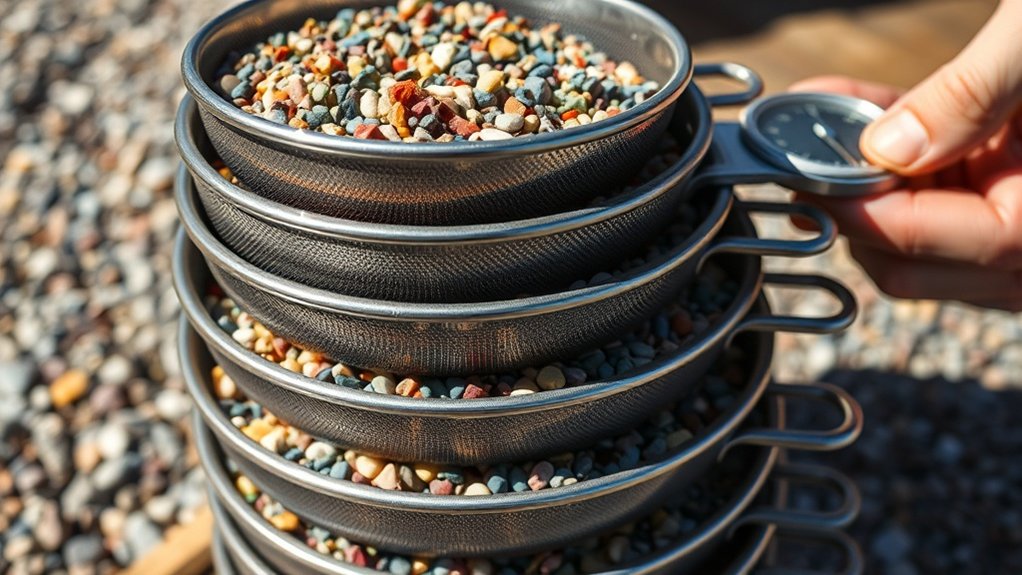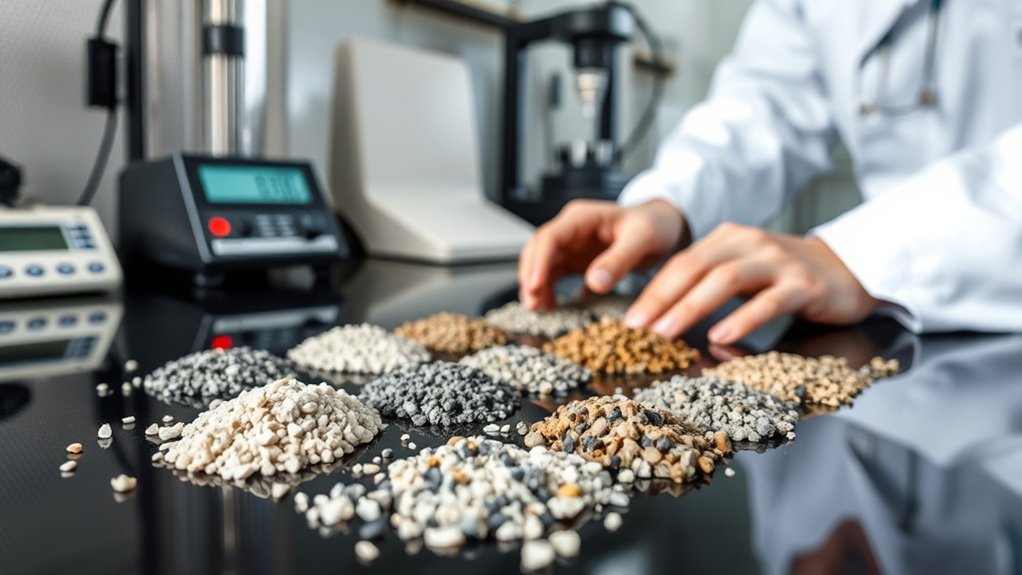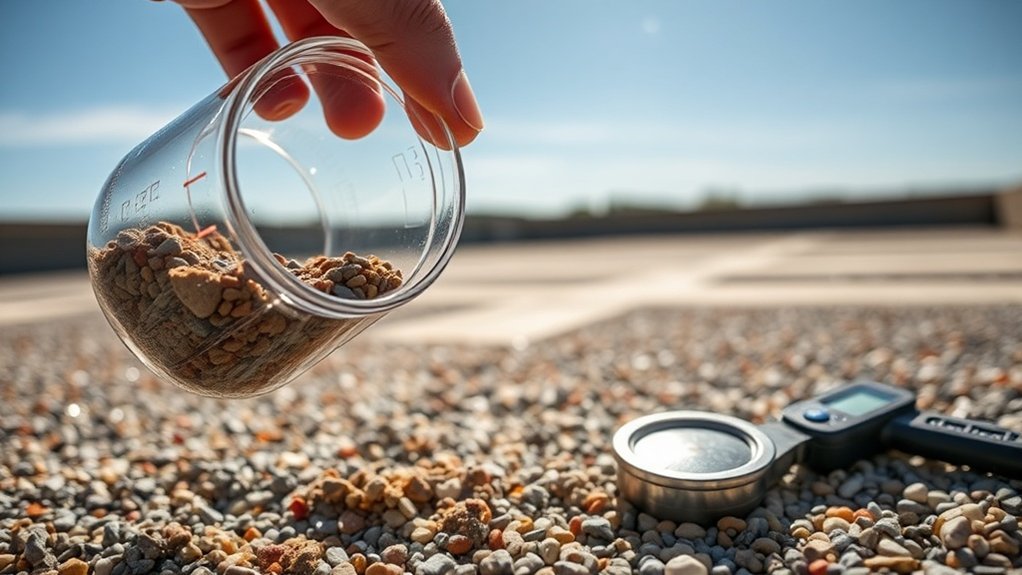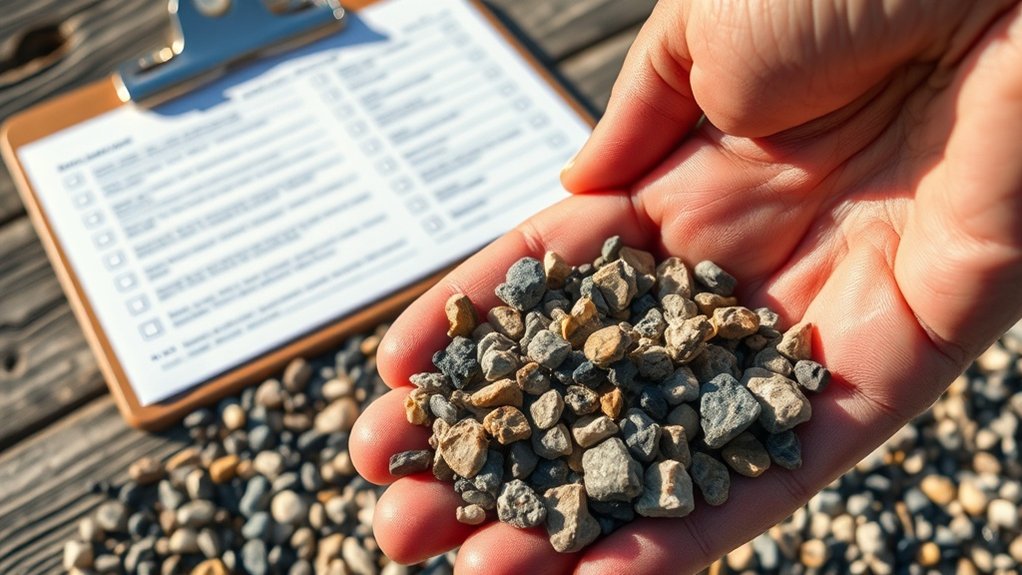To test aggregate quality for resin-bound gravel installations, begin with sieve analysis to ensure the correct particle size distribution. Use an Aggregate Image Analyzer to assess shape and texture, particularly focusing on roundness indices. Perform mechanical properties tests, such as flexural strength and impact resistance, to evaluate durability. It’s also important to check the resin-aggregate ratio for optimal bonding. Don’t overlook the significance of surface preparation and compliance with regulations for the best results. Consider additional techniques and key factors to further improve your installation quality.
Key Takeaways
- Carry out sieve analysis to check particle size distribution and ensure it meets gradation specifications for optimal performance.
- Evaluate aggregate shape and texture with an Aggregate Image Analyzer to accurately assess mechanical interlock and bond strength.
- Conduct flexural, elongation, and impact resistance tests to measure the durability of aggregates under bending, stretching, and unexpected forces.
- Optimise the resin-aggregate ratio, aiming for a resin content of 7% to 10%, while ensuring even aggregate gradation for effective bonding and stability.
- Prepare surfaces thoroughly by removing any contaminants and moisture to enhance resin adhesion and minimise installation defects.
Importance of Aggregate Quality in Resin-Bound Installations

The quality of aggregates is crucial for the performance and durability of resin-bound installations. When sourcing aggregates, it’s important to ensure they’re clean; any dust or impurities can weaken the bond and cause surface problems like cloudiness. Implementing strict quality checks helps ensure you choose aggregates that enhance both durability and appearance. High-quality and uniform aggregates can withstand wear from traffic and environmental conditions. Proper grading is necessary to distribute loads evenly, preventing surface failure. Additionally, using aggregates that are dried to low moisture levels reduces the risks associated with freeze-thaw cycles. This is particularly important because moisture content can lead to unattractive white blooms on the surface. The use of washed and kiln-dried aggregates ensures a better finish and strengthens the resin bond, making it essential for long-lasting results. Aggregates free from foreign materials also support proper resin adhesion and maintain structural integrity.
Sieve Analysis for Particle Size Distribution

Understanding aggregate grading is crucial for optimal performance in resin-bound gravel applications. To accurately determine particle size distribution, follow a precise sieve testing procedure. This analysis not only aids in material selection but also ensures compliance with gradation specifications necessary for both strength and visual appeal. Additionally, grain size analysis determines the percentage of each grain size in a soil sample, providing essential data for quality control. This is particularly important as uniformity in appearance directly influences the overall aesthetic quality of the final product.
Importance of Grading
Grading is crucial for ensuring the quality of resin-bound gravel, as it significantly affects particle size distribution, which is vital for optimal performance. Understanding the importance of grading helps you choose the right aggregates, leading to greater stability and durability. Here are some key points to consider:
- Controls void spaces, enhancing stability
- Influences permeability and drainage efficiency
- Affects surface texture for better slip resistance
- Optimises resin bonding for long-lasting results
- Prevents segregation and weak surfaces
Proper grading techniques help you achieve the desired porosity and packing density while adhering to engineering standards. Additionally, sieve analysis is a method that provides accurate grading data essential for quality control, reducing the risk of issues such as cracking or erosion during the installation of resin-bound gravel. In addition, effective grading ensures that the selected aggregates possess the right level of hardness for wear resistance, making them resilient against various weather conditions.
Sieve Testing Procedure
When performing a sieve analysis for particle size distribution, it’s crucial to follow a clear procedure to ensure reliable results.
Begin by preparing your aggregate sample: dry it at 110 ± 5 °C to eliminate moisture, then allow it to cool to room temperature.
Choose the appropriate sieves, stacking them from largest to smallest, typically ranging from 1 inch to No. 200. Use stainless steel sieves that comply with ASTM E11 standards.
Place the dried sample in the top sieve and use mechanical shakers to ensure consistent results.
After sieving, weigh the material retained on each sieve without removing it, and record these weights. This will help you calculate the mass percentages, providing an accurate analysis of your sample sizes for quality control in resin-bound gravel installations.
Evaluating Aggregate Shape and Texture

Evaluating the shape and texture of aggregates is crucial for ensuring optimal performance in resin-bound gravel applications, as these factors significantly affect mechanical interlock and bond strength with resin binders.
To achieve the best results, keep the following points in mind:
- Use the University of Illinois Aggregate Image Analyzer for accurate shape and texture analysis.
- Measure roundness indices to assess angularity; for instance, crushed gravel typically falls between 72-79.
- Refer to ASTM D3398 for a comprehensive particle shape and texture index.
- Conduct Fine and Coarse Aggregate Angularity tests to evaluate performance characteristics.
- Combine visual assessments with quantitative data to ensure the quality of the aggregate.
Assessing Material Compatibility With Resin

To ensure optimal performance in resin-bound gravel applications, it’s crucial to assess material compatibility with the resin. Start by sourcing aggregates, aiming for a mix of sizes to improve packing and permeability. Conduct compatibility tests that look at grading, moisture content, and chemical composition.
| Factor | Considerations |
|---|---|
| Grading and Size | Use blends; avoid too many fine particles |
| Moisture Content | Keep it under 0.5% by weight for proper bonding |
| Chemical Stability | Choose inert aggregates; check for alkali-silica reactivity |
Evaluating these factors can help avoid problems like uneven surfaces and decreased durability. Always consult supplier documentation for traceability and compliance, ensuring aggregates meet BS EN 12620 standards for reliable performance.
Conducting Durability and Mechanical Properties Tests

After confirming that the material is compatible with the resin, it’s crucial to conduct tests on durability and mechanical properties.
These assessments ensure your resin-bound gravel installation lasts and performs well.
- Carry out flexural strength tests to gauge how well the material resists bending.
- Perform elongation tests to determine how much it can stretch before breaking.
- Assess impact resistance to ensure it can endure unexpected forces.
- Test for freeze-thaw durability to prevent damage from changing temperatures.
- Measure compressive and tensile strength to confirm it can withstand various pressures.
These durability and mechanical tests are vital in ensuring your material meets industry standards, adapts to the UK climate, and remains reliable over time.
Prioritise these evaluations to ensure a top-quality installation.
Abrasion Resistance Testing for Longevity

To ensure your resin-bound gravel installation is durable, it’s vital to conduct abrasion resistance testing to assess its longevity.
Employ methods like the Rotary Drum Test or the Micro-Deval Test to mimic real-world wear and tear. These tests give you valuable insights into how well your chosen aggregates can handle friction and repeated use.
Remember, factors such as the type of material and environmental conditions can affect your results, so it’s important to maintain controlled testing environments.
Proper sample preparation and following established standards will improve the reliability of your findings.
Understanding abrasion resistance not only helps you choose the right materials but also assists in planning maintenance and repair strategies for long-lasting installations.
Optimizing Resin-Aggregate Ratio

Understanding abrasion resistance testing is essential for optimising the resin-aggregate ratio in resin-bound gravel applications.
To improve resin performance and ensure strong adhesion, adhere to these guidelines:
- Target a resin content of 7% to 10% of the total mixture weight.
- Use a balanced mix of 1-3mm and 2-5mm aggregates in appropriate ratios.
- Avoid insufficient resin mixes, as they can lead to weak surface bonding.
- Ensure even aggregate gradation for consistent resin distribution.
- Keep an eye on environmental conditions to adjust resin ratios as needed.
Installation Practices for Quality Assurance

When installing resin-bound gravel, proper surface preparation is crucial for achieving strong adhesion and durability.
Ensure you mix the aggregate and resin accurately to maintain a consistent ratio, as this directly impacts the integrity of the final product.
Additionally, being aware of the curing process is vital to avoid defects and ensure long-lasting performance, even in different weather conditions.
Surface Preparation Importance
Proper surface preparation is crucial for ensuring the long-term performance of resin-bound gravel installations. Achieving a clean surface and managing moisture effectively are key steps before application.
Here are some important factors to consider:
- Remove all contaminants such as dirt, oil, and debris to ensure proper adhesion of the resin.
- Use a pressure washer; simply sweeping may not suffice, particularly in greasy areas.
- Eliminate any vegetation or organic matter that could weaken the base.
- Ensure the substrate is completely dry; moisture can hinder the curing process of the resin.
- Conduct a final inspection to confirm that no debris or moisture is present.
Taking these steps will help guarantee a successful installation.
Mixing Techniques Overview
Mixing techniques are crucial for achieving optimal results with resin-bound gravel installations. Start by using a forced-action mixer to ensure a consistent resin mixture and avoid contamination.
Begin with resin Part A, mixing it slowly for 10-20 seconds before adding Part B. Whisk thoroughly until the mixture is uniformly creamy.
Next, add this blend to pre-washed and dried aggregates, making sure all stones are coated without overmixing. It’s important to keep moisture levels below 0.5%, as too much moisture can weaken the bond.
Stick to consistent mixing times for each batch, as variations can affect colour and quality. Finally, keep detailed records of all mixing conditions for quality assurance, ensuring compliance with industry standards.
Curing Process Considerations
To ensure the durability and longevity of resin-bound gravel installations, it’s crucial to achieve the right curing conditions. Here are key considerations:
- Keep temperatures between 10–30°C; steer clear of extremes.
- Avoid high humidity and rain during the curing process to prevent surface issues.
- Use windbreaks to combat rapid drying and ensure even curing.
- Apply the mixture uniformly at a thickness of 15–20mm for consistent results.
- Record any environmental changes and deviations to uphold quality standards.
Regulatory Standards and Certification Requirements

Regulatory standards and certification requirements are vital for ensuring the quality and safety of resin-bound gravel systems.
Installers must comply with guidelines such as the REACH Regulations, which require training for those handling diisocyanates.
Adhering to Sustainable Urban Drainage Systems (SUDS) is also crucial for effective water drainage.
Certification bodies like the BBA provide recognised standards that confirm product durability and quality, often necessary for public contracts.
It’s important to follow the FeRFA Guidelines for selecting materials and monitoring installations.
Consider enrolling in certified training courses to develop essential installation skills and ensure ongoing competence.
Regular audits are advisable to confirm compliance with these standards and maintain the integrity of your work.
Frequently Asked Questions
What Tools Are Needed for Aggregate Quality Testing?
To test aggregate quality, you’ll need screening equipment, specific gravity testing apparatus, and abrasion testing machines to ensure compliance with established standards. Moisture testing equipment and compression testing machines are also crucial for accurate assessments of aggregate quality.
How Often Should Aggregate Quality Be Tested?
Aggregate quality testing should be carried out according to the frequency guidelines set out in testing protocols. Generally, this means one test for every 500 cubic yards of coarse aggregates. However, you may need to adjust this frequency depending on the scale of your project and the importance of the infrastructure involved. For example, a large construction site or a critical structure may require more frequent testing to ensure quality and safety.
Can Recycled Aggregates Be Used for Resin-Bound Installations?
Yes, recycled materials can be utilised for resin-bound installations. They provide advantages such as cost savings, environmental sustainability, and adherence to regulations. When chosen and tested correctly, they also result in a strong and visually appealing surface. For example, using recycled glass or aggregates can enhance both the look and performance of your installation.
What Environmental Factors Affect Aggregate Quality?
In Shakespeare’s era, weather and soil composition significantly influenced aggregate quality. Changes in temperature, high humidity, and different soil types can weaken bond strength, which in turn affects the durability and performance of resin-bound installations. For instance, using aggregates from clay-rich soils may lead to poorer results compared to those sourced from more stable, sandy soils. Understanding these factors is crucial for achieving long-lasting installations.
How Can I Ensure Safety During Testing Procedures?
To ensure safety during testing procedures, follow the established protocols closely. Always wear personal protective equipment such as gloves and goggles, and ensure your workspace is well-ventilated to reduce exposure to hazardous materials and vapours. For instance, if you’re working with chemicals, using a fume hood can greatly enhance safety.
Conclusion
In summary, ensuring high aggregate quality in resin-bound gravel installations is crucial for durability and performance. It’s surprising that around 30% of installation failures can be linked to poor aggregate selection. By thoroughly testing for particle size distribution, shape, and compatibility with the resin, you can significantly improve your project’s lifespan. Adhering to best practices and following regulatory standards will further ensure a successful installation, leading to more resilient surfaces that endure over time.
